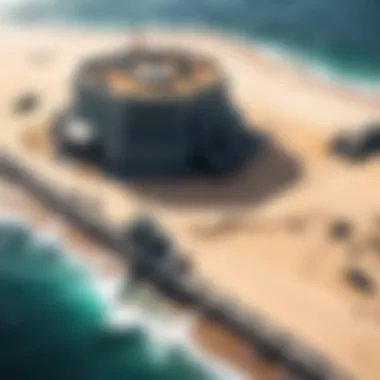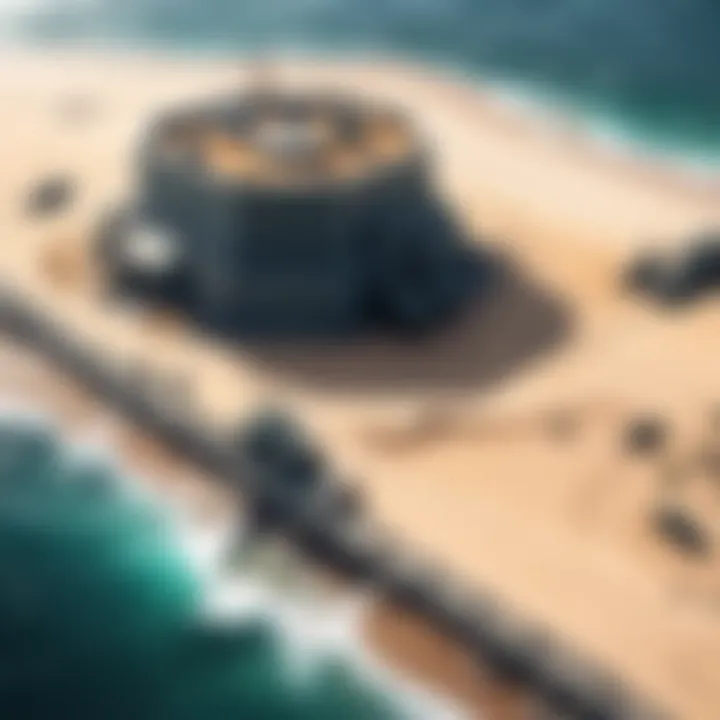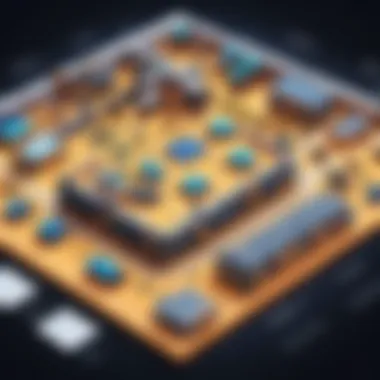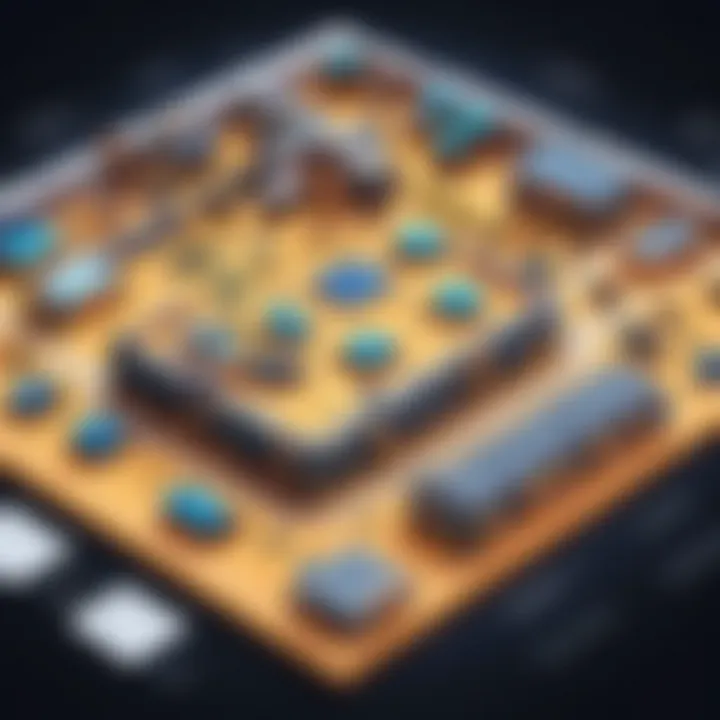Essentials of Basic Tower Defense Games Explained


Intro
Tower defense games have carved a niche in the gaming world, captivating players with their distinctive blend of strategy and intrigue. This genre combines elements of strategy with real-time decision-making, providing an experience where players must think on their feet. The core of tower defense is simple enough: you set up defenses to thwart waves of encroaching adversaries. But, as many seasoned players will attest, the depth of strategy involved is anything but basic.
A major draw of tower defense games lies in how they challenge the player's tactical planning and resource management skills. They force you to consider the layout of the defenses, the types of enemies you'll face, and the optimal placement of your towers. Each level presents new threats and requires adaptive strategies to respond effectively.
In this exploration of the essentials, we will break down the fundamental mechanics and features that have propelled tower defense games into the spotlight. We’ll delve into the evolution of the genre, analyze design principles, and consider the various strategies that can be employed. Whether you’re an old hand at the craft or just dipping your toes into the genre, there’s something here for everyone.
Prelims to Tower Defense Games
When diving into the realm of gaming, understanding the foundations becomes crucial, and that’s where tower defense games come into play. These games not only entertain but also stimulate critical thinking and strategic planning. From a casual afternoon of gaming to more intense sessions, they encapsulate complexity within simplicity, making them an intriguing topic of discussion.
Definition and Gameplay
At their core, tower defense games are a genre where players must stop waves of incoming enemies by strategically placing defensive structures—known as towers—along a predefined path. The objective is quite straightforward: prevent enemies from reaching a designated point, often referred to as the base or home.
Players are given resources to build and upgrade towers, each with unique attributes and abilities. This leads to essential decisions about which towers to construct, where to place them, and when to upgrade them. Tower placement is key; a well-placed tower can deal significant damage, while a poorly positioned one may end up powerless. The moment-to-moment gameplay often involves a blend of quick decision-making and long-term strategy, as players balance immediate threats with future waves.
History and Evolution
The origins of tower defense games trace back to the early 1990s, with some of the earliest games emerging on PCs. Titles like Rampart introduced the basic mechanics of building defenses against opponents, laying groundwork for what would come later. As technology advanced, so did the genre, notably with Bloons Tower Defense in the mid-2000s, which propelled tower defense to mainstream popularity.
The evolution of tower defense games is marked by both advancements in graphics and gameplay mechanics. Initially, many games utilized a top-down 2D view, but modern iterations have embraced 3D graphics, rich environments, and more immersive storytelling. Moreover, with the introduction of mobile gaming, the accessibility of tower defense titles has exploded, drawing in a wider audience.
Tower defense games showcase how strategic depth intertwined with simple game mechanics can captivate players across generations.
In summary, exploring the essentials of tower defense games offers insights not only into their gameplay mechanics but also into their historical significance in the gaming landscape. Whether you are a seasoned gamer or just starting out, the foundations of tower defense will enhance your understanding and appreciation of gaming as a whole.
Core Mechanics of Basic Tower Defense Games
Understanding the core mechanics of basic tower defense games is crucial not only for grasping the genre but also for mastering its intricacies. These mechanics form the backbone of gameplay, guiding players through various challenges while unfolding strategies that can lead to victory or defeat. By diving deep into these elements, one can appreciate the balance between tactical deployment and resource management that underpins every successful defense strategy.
Game Objectives
At the heart of any tower defense game are clear and enticing objectives. Players are typically tasked with preventing waves of enemies from reaching a designated point, often referred to as the ‘base’ or ‘core’. Achieving this requires players to set up a series of towers along a predetermined path. Each tower serves a purpose, whether it's to damage, slow down, or incapacitate foes. The objectives vary slightly across games but generally revolve around:
- Survival: Keep your base intact for as long as possible, often measured against increasingly difficult enemy waves.
- Resource Accumulation: Collect in-game resources that can be used to build and upgrade towers. These resources can be awarded for defeating enemies or through special bonuses.
- Strategic Development: Players might face scenarios where they must adapt their tactics based on enemy types or behaviors, making strategic planning essential.
The way objectives are structured can greatly influence player engagement. When accomplished, overcoming these challenges not only results in satisfaction but also encourages replay through escalating difficulty levels.
Tower Placement Strategies
Proper tower placement is the linchpin of effective defense. A hasty decision can lead to a swift defeat, while a well-thought-out strategy can fend off waves of attackers. Players need to consider several factors:
- Pathing of Enemies: Knowing where the enemies will move is essential. Players should choose tower locations that maximize their range and minimize the enemies’ ability to reach the base.
- Tower Synergy: Certain towers complement others. For example, a slow tower can be placed near stronger firepower to give it more time to eliminate tougher foes. Players often have to experiment to find the best combinations.
- Resource Allocation: Each tower requires resources to build and upgrade, so decision-making plays a vital role. Players must decide whether to save resources for high-cost towers or to spread them out for immediate defense.
To enhance strategic depth, some games introduce environmental factors. These may include terrain that affects tower deployment or external buffs that can alter gameplay dynamics.
Resource Management
Resource management is pivotal in mastering tower defense games. Players start with a limited number of resources and must efficiently allocate them toward constructing and upgrading towers. Here are some key considerations to keep in mind:
- Scarcity of Resources: Unlike other genres where resources can be constantly generated, tower defense often limits this aspect, pushing players to make calculated choices about where to invest.
- Balancing Immediate Needs vs. Long-term Growth: Players must juggle the necessity of addressing current threats against the prospect of upgrading towers for the tougher enemy waves to come.
- Opportunity Cost: Every resource spent on one tower means potentially losing out on another. This aspect forces players to analyze the game situation continuously and make trade-offs that will influence the impact of their strategy.
"Effective resource management can be the difference between survival and destruction in a tower defense game."
In summary, the core mechanics of tower defense games are essential for creating a rewarding and engaging gaming experience. Mastering the objectives, placement strategies, and resource management will undoubtedly contribute to a player's success, providing layers of depth and challenge that enrich the gameplay.
Types of Towers in Defense Games
In the world of tower defense games, towers are not just static structures; they’re the backbone of your strategy and defense mechanism. Understanding the various types of towers helps players develop diverse strategies and optimize their gameplay experience. Each tower type comes with distinct characteristics, influencing their effectiveness against different types of enemies and scenarios. This section breaks down the main types of towers you’ll encounter, emphasizing their roles, benefits, and considerations.
Attack Towers
Attack towers form the front lines of your defense. They are primarily focused on delivering damage to advancing enemies. These towers vary in the type of damage they deal, which can broadly include physical, magical, and elemental damage. Some may fire projectiles, while others might employ area-of-effect attacks that can hit multiple foes at once.


- Key Features:
- High damage output
- Various attack ranges
- Different damage types to counter specific enemy strengths
Attack towers are essential for thinning out enemy hordes before they reach critical points. Choosing the right attack tower based on the wave of enemies approaching is crucial. For instance, if faced with heavily armored foes, a tower that deals physical damage is more effective than one that relies on magical attacks. A good strategy is to have a mix of different attack towers to deal with various enemy types efficiently.
Support Towers
While attack towers handle the brunt of enemy onslaughts, support towers play a different role by enhancing the overall effectiveness of your defenses. These towers often provide buffs to nearby attack towers or lay traps that impede enemy movement.
- Common Functions:
- Healing nearby towers
- Reducing enemy speed
- Increasing the damage output of allied towers
Implementing support towers can shift the tide in fierce battles; for example, placing a healing tower near a cluster of attack towers can prolong their operational time against waves of relentless adversaries. Another possibility is using slowing towers that can catch fast-moving enemies, giving your attack towers more time to eliminate threats before they reach your base.
Special Towers
Special towers introduce unique mechanics or abilities that differentiate them from the conventional attack and support types. These towers might weave in innovative strategies or applied synergies that can drastically alter the course of a match.
- Traits of Special Towers:
- Unique abilities with cooldowns, such as nuclear strikes or elemental blasts
- High resource costs requiring careful planning and timing for optimal use
- Potentially game-changing effects, like summoning temporary allies or creating protective barriers
Integrating special towers into your strategy can give you an edge in crucial encounters. For instance, a well-timed strike from a special tower during a boss fight can deliver the knockout punch needed to turn the battle in your favor. Therefore, understanding the timing and placement of these towers is essential for maximizing their potential.
"The right mix of tower types can create a symphony of defense that’s greater than the sum of its parts; knowing when and where to place each type is the art of a master strategist."
In summary, the combination of these tower types allows players to develop tailored strategies that suit their preferred play style, enhance their defenses, and encapsulate the essence of tower defense gaming.
Enemies and Their Characteristics
Understanding the enemies in tower defense games is fundamental for players aiming to master gameplay and design strategies. Each enemy brings unique attributes and challenges, influencing how players set up their towers and manage resources. Recognizing what makes each type of enemy tick is crucial for successful defense—a well-informed player can turn the tides, even when the odds seem stacked against them.
Enemy Types and Abilities
In the realm of tower defense, the variety of enemies is vast. Commonly, you encounter several archetypes, each with distinctive abilities:
- Standard Enemies: These basic adversaries are often weak yet numerous. They form the backbone of enemy waves and test basic tower effectiveness.
- Armored Enemies: Heavily fortified, these foes resist damage better than others, requiring players to invest in stronger towers or specific upgrades to handle them.
- Fast Enemies: Speedsters can sprint past slower towers, necessitating strategic placement of more rapid-firing defenses or slowing mechanisms.
- Flying Enemies: These units can bypass ground towers, demanding players to include aerial defenses in their layouts.
- Boss Enemies: Typically appearing at the end of a wave, bosses combine high health and varied abilities, often representing a significant challenge and requiring specific strategies to defeat.
Each enemy's behavior is also compelling; for instance, some might regenerate health over time, while others may spawn additional minions once defeated. This multifaceted approach keeps players on their toes, requiring adaptability and foresight. In essence, the mix of enemy types adds depth, making strategic planning a necessity rather than an option.
Progressive Difficulty Levels
The concept of escalating difficulty is a hallmark of engaging game design, especially in tower defense. Typically, levels are structured in a way that gradually introduces tougher enemies, tighter budgets, and complex strategies. This progression serves several functions:
- Skill Development: New players start with basic waves that allow them to learn the mechanics without being overwhelmed. As layers of complexity unfold, they develop their strategies.
- Engagement: A well-timed increase in challenge keeps players invested. It prevents monotony and ensures excitement with each level. When players feel the pressure of stronger foes, their investment in the game rises.
- Resource Management: The need to adjust strategy under pressure forces players to analyze their towers and abilities frequently. The game effectively teaches them how to allocate scarce resources wisely.
"In tower defense gaming, the key isn’t just to survive; it’s to adapt and thrive as the game’s challenge escalates."
At the core, the balance between feeling challenged and capable is a fine line that good game design navigates proficiently. This delicate progression is what maintains a game’s longevity and keeps players returning for more.
In summary, enemies in tower defense games are not just obstacles—they contribute to the game's dynamic, shaping how players interact with the system. From understanding the myriad of enemy types and their specific abilities to appreciating the carefully designed difficulty scaling, players gain insights that enhance both gameplay experience and strategic planning.
Player Strategies and Techniques
In the realm of basic tower defense games, the players’ strategies and techniques are often the heartbeat of success. Understanding how to effectively navigate this dynamic gameplay can transform a struggle against waves of enemies into a calculated victory. Players need to harness specific elements – like tower placement, upgrade paths, and timing – to elevate their game, ensuring not only survival but an exhilarating experience.
Effective Tower Placement
Effective tower placement is akin to mastering a game of chess. The choices players make about where to set up defenses can drastically alter outcomes. For instance, positioning towers at bends in the path can maximize the time enemies spend in their line of fire, allowing for greater damage.
Consider the following when placing towers:
- Path Control: Towers placed on corners or turns can slow down enemy movement, increasing the efficacy of attacks.
- Range Considerations: Understanding each tower's attack range is crucial. Placing long-range towers towards the back allows for better coverage and safety from direct attacks.
- Synergy between Towers: Combining different types of towers together can create lethal zones. For example, an attack tower combined with a slowing tower can exponentially increase the destruction dealt to oncoming foes.
The right placement not only fends off enemy waves but also builds a strategic advantage, often distinguishing the amateurs from the veterans.


Upgrade Path Optimization
In a tower defense game, upgrading is often as critical as initial placement. Players must make thoughtful choices regarding which towers to enhance and when. Not every tower necessitates immediate improvement; understanding the upgrade paths can save valuable resources and optimize firepower.
When considering upgrades, the following factors matter:
- Resource Allocation: Players need to keep an eye on resources and consider which tower's performance could change the tides of battle most effectively with investments.
- Enemy Behavior: Certain enemies require specific types of damage or control. Players must prioritize upgrading those towers that counter these threats.
- Gradual Investment: Sometimes it might be wiser to upgrade lower-cost towers first, as they can become powerhouses if strengthened accordingly, thus ensuring steadier progress against incoming waves.
In essence, optimizing the upgrade paths leads to a more resilient defense while preserving the broader resource economy.
Timing and Anticipation
Mastering timing and anticipation in tower defense is much like an art form; it hinges on predicting enemy patterns and adapting strategies accordingly. The key lies in the possibility of recognizing when to build additional defenses or when to unleash powerful upgrades.
Here are elements to consider for effective timing:
- Wave Patterns: Understanding the spawn timings and types of waves arriving is vital. Players who can anticipate the enemy's arrival can adjust their strategies in real-time.
- Cooldown Management: Many towers have cool down periods after firing. Players must time their attacks and upgrades to align with these cooldowns, ensuring a continuous assault.
- Resource Timing: Spending resources frivolously can lead to dire consequences. Players should wait for optimal moments to deploy or enhance defenses, avoiding any possibility of rushing into resource depletion.
"Success in tower defense often lies in your ability to read the battlefield and adapt to changing circumstances."
Together, these strategies create a formidable foundation for players eager to excel in tower defense games. Through effective tower placement, keen upgrade path optimization, and masterful timing, players not only protect their realms but also enhance their strategic thinking skills. As players apply these techniques, they cultivate deeper engagement with the game, ultimately enriching their overall gaming experience.
Aesthetic Elements of Tower Defense Design
Aesthetic elements in tower defense games serve more than just a decorative purpose; they create an immersive environment that enhances player engagement and shapes gameplay experiences. As players allocate their resources and strategize their defenses, the visual and auditory appeals truly matter. These elements can provoke emotional responses, contributing to a player’s sense of achievement or frustration, which is crucial in the fast-paced dynamics of tower defense games.
Art Style and Visuals
The art style in any tower defense game can vary enormously, from cartoonish graphics to complex, high-definition environments. Choosing a specific art style is a significant consideration for developers, as it sets the tone of the game. In more whimsical tower defense games, vibrant colors and exaggerated animations might be used. For example, Kingdom Rush employs a colorful palette and charming character designs, offering an inviting atmosphere that contrasts with the strategic intensity of gameplay. Conversely, games like Bloons Tower Defense 6 use a more detailed and semi-realistic style that enhances the vibrancy of its gameplay elements.
Visual clarity is also paramount. Players need to distinguish between different units, towers, and enemy types easily. Ambiguous or cluttered visuals can lead to confusion during critical moments, impacting a player's ability to respond in real time. Clean interfaces, intuitive design, and organized layouts ensure that the aesthetic elements serve the gameplay rather than distract from it.
Additionally, environmental design plays a crucial role. Levels that provide variety in aesthetics—from lush forests to barren deserts—help keep the game fresh. Each setting can introduce unique hazards or advantages that align with the visual narrative of the game. The careful crafting of levels supports player immersion and keeps them engaged long term.
Sound Design
Sound design is equally important in the realm of tower defense. Not only does it enhance the experience, but it also signals critical gameplay elements. The right sound effects can elevate the tension during gameplay—think of the chilling sounds of oncoming enemies or the satisfying thud of a successful tower upgrade. These aural cues create a rhythm that players learn to anticipate, which can make or break their strategy.
Moreover, a well-composed soundtrack can encapsulate the game’s essence. For instance, a light-hearted game may employ upbeat, whimsical tunes, while a much grittier tower defense game could feature darker, more intense scores. This auditory backdrop assists in establishing an emotional connection, allowing players to immerse themselves deeper into the game world. It’s the kind of detail that keeps players coming back, creating associative memories tied to each sound.
"Sound design elevates the entire gaming experience, making it not just about what you see but what you hear."
Finding the right balance is key; too much noise can overwhelm a player, while too little can lead to a sterile experience. Designers need to pay close attention to how sound blends with visuals and gameplay mechanics, creating a cohesive, engaging atmosphere that resonates with players.
Integrating these aesthetic elements with a keen focus on player experience ultimately shapes how a tower defense game is perceived and enjoyed. It’s not just about raw functionality; it's about crafting an experience that keeps players invested and returning for more.
Technological Innovations in Tower Defense
The landscape of tower defense games has evolved considerably over the years, largely driven by advances in technology. This section digs into how innovations have impacted gameplay and engagement. From improved graphics to enhanced multiplayer setups, tech has reshaped not just how these games are played but also how they are perceived by a growing player base.
Mobile Optimization
Mobile optimization has turned tower defense games into a ubiquitous experience—accessible to anyone, anywhere. Back in the day, you had to huddle around your computer, but now you can wage a strategy war on your daily commute. The touch interface makes it simple; just tap here, drag there. This ease of use has led developers to focus on creating games that play smoothly on smaller screens.
The benefits of mobile optimization go beyond just convenience. It also opens the door for features like positional audio and adaptive difficulty, enhancing immersive experiences. Developers have to consider varying screen sizes, battery life, and internet connectivity too. Although it sounds simple, the technicalities behind it are quite intricate.
Moreover, local and online leaderboards have sprouted in mobile games, adding competitive flair. Take Bloons TD 6, for instance. It showcases how mobile optimization can elevate gameplay through fast-paced mechanics and multiplayer options that engage players at different skill levels. In this scenario, optimization isn’t just a box to tick off; it’s crucial for retaining player interest.
Multiplayer Features
Multiplayer features represent a real turning point in tower defense gaming. Before this, it was often a solitary conquest against waves of enemies, where your only opponent was your own strategy—and sometimes your mistakes. Nowadays, you can team up or compete against friends in real-time, which amplifies the excitement.
Incorporating multiplayer dynamics introduces elements like cooperative strategies or versus modes, pushing players to think critically. Let's not brush aside the social aspect either; collaborating with friends creates shared experiences. Players communicate strategies via chat or voice, sometimes leading to memorable moments, like the time when everyone underestimated a particularly tricky wave.
What's interesting is how multiplayer features often incorporate cross-platform play. Players on mobile can easily connect with those on PCs or consoles. As a result, games like Kingdom Rush: Frontiers have embraced this feature, making it easier to invite friends into the mix regardless of their choice of device.


As one might say, the rise of multiplayer has changed the game entirely, turning solitary strategists into a thriving community.
"The strength of tower defense games today lies in their ability to connect players across various platforms, making strategy not just a solo endeavor but a shared experience."
Overall, these technological innovations have not only modernized tower defense games but also made them reflective of today’s social and mobile-savvy culture. The integration of these advancements has played an undeniable role in ensuring the genre remains relevant and attractive for both seasoned players and newcomers alike.
The Role of Community in Tower Defense Games
The community surrounding tower defense games plays a crucial role in shaping the gaming experience and further promoting the genre. When players come together, they exchange strategies, troubleshoot gameplay, and discuss the latest trends, allowing both newcomers and veterans to deepen their understanding of the games they love. This shared atmosphere cultivates a sense of belonging and drives the genre's evolution, fostering innovation and creativity among developers and players alike.
Forums and Online Discussions
Forums are the watering holes of the tower defense community, where enthusiasts gather to share tips, celebrate victories, and dissect gameplay mechanics. Websites like Reddit and dedicated forums allow players to express their thoughts freely and engage in discussions that can range from strategy breakdowns to the impact of updates on gameplay.
Here's what you can find in these forums:
- Strategy Guides: Players often post in-depth analyses of their favorite games. For instance, a guide may explain detailed tower placement based on enemy types and map layouts.
- Dev Updates: Game developers frequently engage with the community through these platforms, providing insights into upcoming features or changes, which keeps the player base informed and excited.
- Technical Help: Issues with gameplay can get frustrating. Forums serve as a support system, where players can ask questions and find technical solutions from more experienced gamers.
In these discussions, players not just critique but also contribute to the game development process by voicing their opinions. This input can lead to patches and improvements that directly enhance the player's experience, demonstrating how community feedback can become an essential part of game evolution.
User-Created Content
User-generated content, often seen in the form of mods, fan art, and level designs, adds a unique flavor to tower defense games. These creations reflect the rich creativity of the community and can significantly enhance gameplay.
For example:
- Mods: Players create modifications that can change game mechanics or introduce new towers and enemies. The OpenRA mod for example, which brings classic real-time strategy games into a new engine, shows how community innovation can lead to revitalized gameplay experiences.
- Fan Art: Artists often produce illustrations of characters and settings, enriching the game's visual narrative and allowing players to see their favorite elements reimagined.
- Custom Levels: Some games actively encourage the creation of custom maps and levels, giving players the opportunity to design challenges that test their skills and creativity.
In a nutshell, within the broad tapestry of tower defense games, user-created content vividly illustrates the collaborative spirit of the community. The interplay between developers and players not only enhances the enjoyment of the game but also amplifies its longevity and relevance in a fast-evolving gaming landscape.
"The best games are those that thrive on community collaboration, taking player feedback and creativity into account, which creates experiences that are ever-evolving and exciting."
In closing, the role of the community in tower defense games is indispensable. From driving discussions in forums to generating remarkable user-created content, it galvanizes player engagement, ensuring that the genre continues to grow and adapt to meet the desires of its audience.
Future Trends in Tower Defense Gaming
The landscape of tower defense gaming is continually shifting, much like the tides at sea. Understanding the future trends in this beloved genre is paramount for developers, players, and enthusiasts. As new technologies emerge and player preferences evolve, tower defense games are not merely stagnant; they are blossoming into a more intricate and engaging form. In this section, we delve into the budding mechanics that are transforming gameplay experiences and the infusion of cutting-edge technologies like AI, which represents both the challenges and opportunities in tower defense gaming.
Emerging Mechanics
The introduction of emerging mechanics can often redefine how players interact with games. Let's unravel a few notable trends:
- Dynamic Terrain: Environments that can change mid-game provide players with new barriers and strategic opportunities to rethink their tower positioning and resource allocation. This adds a layer of depth previously unseen in conventional formats.
- Co-op Gameplay: Cooperative features are gaining traction where players can work together to fend off waves of enemies. This enhances social interaction and strategy formulation—two minds might just manage to place those towers more efficiently than one.
- Multi-lane Defense: Rather than sticking to a single path for enemies, multi-lane approaches let players manage several routes at once. This can escalate tension and strategy, as neglecting even a single lane can spell disaster.
- Unit Customization: Allowing players to customize or evolve their towers or units serves to further deepen engagement. Each player can develop their unique strategies and defenses tailored to individual playstyles.
"Incorporating new mechanics can breathe fresh life into a genre, keeping the player community engaged and invested in their gaming experience."
Integration of AI and Machine Learning
The integration of AI and machine learning isn't merely a luxury; it's becoming a fundamental requirement for modern game design, including tower defense genres. By incorporating these technologies, developers can create a more responsive and adaptive gaming environment. Here are ways that AI and machine learning are shaping the future:
- Adaptive Enemy Ai: Enemies can learn from player tactics and adapt their strategies accordingly, which raises the stakes and requires players to continuously rethink their defenses. This ensures that each playthrough feels unique and challenging, preventing the game from becoming monotonous.
- Predictive Algorithms: Leveraging machine learning enables the game to predict player behavior and tailor challenges dynamically. Imagine a scenario where the game recognizes that a player repeatedly fails at a certain point and adjusts the difficulty just enough to offer a fighting chance without being patronizing.
- Enhanced Player Engagement: AI can also analyze player performance data to suggest strategies or recommend custom tower layouts suited to the player’s previous performance. This level of personalization adds to the overall experience and can lead to higher retention rates.
Tower defense games are on the brink of immense transformation, driven by both player desires and technological advancements. The more engaging mechanics and the smarter AI become, the more deeply players can become immersed in their defensive strategies.
Epilogue
In wrapping up our exploration of basic tower defense games, we shine a light on a genre that marries strategy, attentiveness, and a dash of creativity. Tower defense games are often seen as simple yet captivating, giving players the chance to test their decision-making skills under pressure. The importance of this genre extends beyond mere entertainment; it paves the way for cognitive development by engaging players in critical thinking and real-time resource management.
Summarizing Key Insights
To revisit the fundamentals we’ve discussed:
- Game Mechanics: Fundamental rules dictate how players create defenses and manage resources effectively, underscoring necessity for adaptability.
- Types of Towers: Each tower type serves a unique role, emphasizing strategic diversity for players. Be it attack, support, or special towers, understanding these nuances can change the game.
- Enemy Characteristics: Knowledge of enemy types and their progression provides a comprehensive edge, allowing players to adjust strategies on the fly.
- Community Engagement: The influence of forums and user-generated content cannot be underestimated; the community drive often enhances the gaming experience.
These insights, when pieced together, articulate a vivid picture of both the complexity and allure of tower defense games. Players are not just thwarting敌人; they are engaging in a thoughtful exercise in strategy and foresight.
Final Thoughts on the Genre
While this genre may possess its roots in simplicity, the layers of strategy, community interactions, and aesthetic designs contribute to a rich depth that continuously attracts tech-savvy individuals.
The evolution of tower defense games hints at a promising future, with innovations like incorporating AI and advanced player mechanics on the horizon. For enthusiasts and newcomers alike, these games hold keys to not only enjoyment but also to sharpening tactical skills that can be applied beyond the screen.
The blend of art, technology, and challenging gameplay generates an ongoing cycle of interest. Ultimately, whether you’re crowding the battlefield with various towers or contemplating your next move, it’s clear that the essence of tower defense games will continue to thrive.







